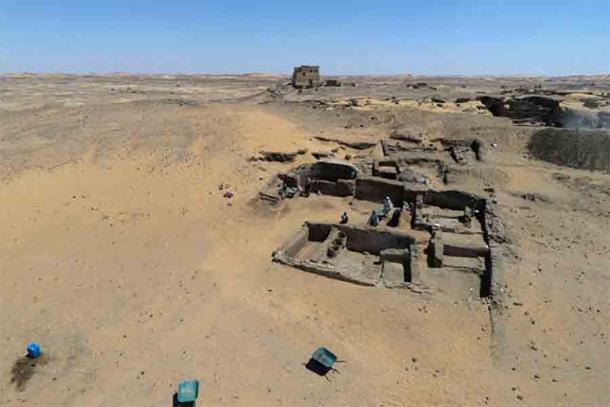Sometimes archaeology demands that history be revised. Recent discoveries in Old Dongola, in modern-day Sudan, appear to have unearthed the need to reappraise the entire history of the Nubian church. In Old Dongola , the ancient capital of Makuria and one of the three Christian Nubian kingdoms, archaeologists have found the remains of what they suspect is “the largest church known from medieval Nubia.”
Old Dongola is a deserted town located on the east bank of the Nile. It was a thriving town for over 1,200 years, from the end of the 5 th century up until the 18 th century when the city was abandoned. When the Nubian kingdom converted to Christianity, the city expanded beyond the citadel. A team of archaeologists from Poland has been excavating the site, which covers about 200 hectares (0.77 sq mi), since the 1960s.

Excavation of a 17 th century domestic compound which was built on top of the Nubian church. ( A. Chlebowski / PCMA UW )
Nubian Church Discovery Opens Doors to Change in History of Sudan
According to Artur Obłuski, the head of the Dongola expedition and director of the Polish Centre of Mediterranean Archaeology of the University of Warsaw (PCMA UW), the building might have been the seat of an archbishop governing the church hierarchy over a 1000 km-long (621 mile) stretch along the Nile. This “changes” not only what is known about the city itself, “but also the way we reconstruct the history of the Nubian church,” explained Obłuski.
The archaeologists believe that the archbishop of Dongola oversaw the bishop of Faras, whose cathedral was discovered 60 years ago by Polish archaeologist Kazimierz Michałowski. Faras Cathedral was famously covered in well-preserved paintings. Since the 1960s, archaeologists from PCMA UW have been exploring ancient Faras which was the capital of Nobadia. This major city in Lower Nubia is located on the border between modern Egypt and Sudan.
According to an article on the PCMA UW website, the church’s apse, which measured about 26 meters (85 ft) long, and the dome of a tomb were cleaned earlier in 2021. The apse has a diameter of 6 meters (19.6 ft) and it is painted with two rows of monumental figures. The researchers say this is “the largest apse so far discovered in Nubia.” Furthermore, according to Science Poland , Obłuski said if his team’s estimates are right, based on the known dimensions, this is “the largest church discovered so far in Nubia.”

Wall painting discovered at Faras in the 1960s. ( Public domain )
Big Domes on Nubian Churches Meant Bulging Bank Accounts
So often men claim “size is important,” but professor Obłuski directs this sentiment towards several aspects of his new research. Firstly, the building is located at the heart of a “200-hectare city” that represented the capital of the combined kingdoms of Nobadia and Makuria, so it was of supreme importance.
What’s more, to the east of the building was the domed tomb of Joannes who served the city as the bishop of Faras. While the dome over Joannes’ tomb is only 1.5 meters (4.92 ft) in diameter, the dome over the Dongolese building is 7.5 meters (23 ft) in diameter. In ancient Nubia the size of one’s dome really was important as it reflected wealth and power.
Now, standing in the middle of a citadel surrounded by a 10-meter high (32.8 ft) and 5-meter thick (16.4 ft) wall, just like at Faras, it is suspected the newly explored super-church in Dongola served as a cathedral. Again following the pattern observed at Faras, beside the building is a bishop tomb. Archaeologists have also discovered ruined “churches, a palace, and large villas belonging to church and state elites.”

Archaeologists documenting the Nubian church discovered at Old Dongola. (A. Chlebowski / PCMA UW )
“New” Nubian Church Changes Previous Hypotheses
Until this discovery another church outside the citadel was believed to be Dongola’s cathedral, but Obłuski says “confirmation of this new hypothesis [building] will have significant consequences for Nubiology,” establishing this as the new heart of the entire kingdom in the Makurian period.
Before any further excavations can be carried out, restorers must first strengthen patches of weakened and peeling wall plaster. After this, the entire site must be carefully cleaned. The next step will involve erecting a temporary roof over what is being described as an exceptionally valuable site. Unlike the Faras dig, the paintings on the walls will be left on the church walls.
In Western religious terms this like finding another, slightly larger, Vatican on the other side of Italy. A discovery like that would necessitate a complete review of the history of the Catholic church. In this case, the finding of a Nubiansuper-church means that historians and archaeologists will now need to review their previous assumptions about the formation and early history of Nubian Christianity.
Top image: Digital 3D image of how the newly discovered Nubian church could have looked. Source: A. Wujec / PCMA UW
By Ashley Cowie
Related posts:
Views: 0
 RSS Feed
RSS Feed

















 June 4th, 2021
June 4th, 2021  Awake Goy
Awake Goy  Posted in
Posted in  Tags:
Tags: 
















